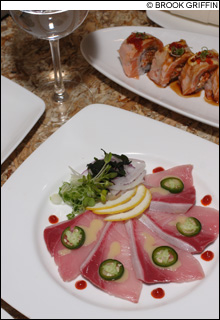|

GRAZE AWAY: on small plates at Douzo.
|
Douzo is supposed to mean something like “welcome” in Japanese, and a large crowd has already welcomed this large, shiny, sushi-plus restaurant to its location near Back Bay station. All the food I tasted was excellent; my only concerns are — ironically, given the place’s name — with the “welcome” part. The restaurant doesn’t take reservations for parties of fewer than six, so you come and wait. As at all new restaurants, the wait can be unpredictable, although early one weeknight ours was gauged at 20 minutes and ran about half of that. We were signaled by a flashing pager like the one you get at a Cheesecake Factory. (This is douzo?) We were able to order appetizers at a bar table while waiting and transferred the order to our table without a problem. But the parking situation is unclear. I had read about $5 validated parking, inquired of a Friday-night valet, and was offered $16 valet parking instead. On a weeknight, there was no valet in the marked valet area.
Once you get in, Douzo is all brilliant surfaces and lounge electronica, three tiny TVs over the bar silently playing the Red Sox game, and the happy talk of young fans of innovative maki. Owner Jack Huang used to own part of Fugakyu, and Douzo’s menu style (lots of sushi and sashimi, with a smattering of hot appetizers and entrées) is similar. The room is a dramatic duplex with a sunken dining room to emphasize that. Its tables seem to be made of heavily urethaned composition board — a neat semi-industrial spin on the yellow pine of traditional Japanese restaurants — with white-and-black panels and decorative references to origami.
There are an enormous number of appetizers and small plates, and not all of them are so unusual. Some are: the baked scallop kayami ($9.25), which is actually scallop meat and perhaps some cheese but certainly spicy mayonnaise, baked into a meaty, peppery, not-very-Japanese mess of deliciousness in a large sea-scallop shell. I also hadn’t seen this version of ohitashi ($4.50), in which the spinach is compressed into four small cylinders and dressed with tahini instead of sesame seeds and soy. “Douzo’s spareribs” ($8.50) aren’t very Japanese, although they aren’t the familiar Chinese-American items either. Think of them as nouvelle Chinese-American: three meaty ribs without much seasoning (maybe a bit of five-spice dust), broiled cleanly and presented on shredded red cabbage — the most un-Asian cabbage you can buy.
Sweet-potato tempura ($6.75) is a remarkably successful spin, the sweet potato coming through in fried barrels with a bit of batter, and only spun a little by sesame seeds and a soy dressing. Tuna tempura ($11.75) — fried tuna — doesn’t sound so good. But fried tuna rolled with seaweed around a scallion makes five dandy bites. You can ignore the garnish of red cabbage and chow mein noodles, and even the thin mustardy dip. Cucumber rolls, which are turning up all over, are like low-carb sushi. Chefs trained to make wafer-thin slices of raw fish can do amazing things with cucumbers. Spicy yellowtail-cucumber roll ($7.75) is actually a cone of thin cucumber, with a filling of raw fish and spicy mayonnaise. It’s scrumptious.
Douzo does more-familiar if more-expensive things with shumai ($6.50), white miso soup ($3.75), edamame ($4.75), and tuna tataki ($10.25), the unfused fusion dish of seared-edge tuna in sashimi slices. Scorpion maki ($10.75), a sushi without raw fish, is becoming a cliché; in case you haven’t yet jumped on the bandwagon, it’s an avocado roll with thin-sliced cooked shrimp on top to make the scales. The eight or nine pieces fill you up, or you can share with a crowd. I did enjoy one old favorite from Fugakyu: a roll of eel and avocado ($6.50). Again, everything is cooked, but the avocado’s neutral richness perfectly extends the flavor of broiled eel.
Entrées seem like an afterthought on this menu made for grazing and drinking, but Douzo has a fair assortment of Japanese platters, including steak and lobster, and I’ll bet they are good. Sukiyaki ($23) is a sweet stew of tender beef slices, wonderfully improved silken tofu, bits of fish sausage, broccoli, carrots, and cellophane yam noodles served in an iron pot. Salmon teriyaki ($19) was a handsome, large slice with a nice glaze, a side of cooked noodles with fried-rice vegetables, and a garnish of underdone broccoli.
One unusual platter is the “omakase special” ($45). “Omakase” means “chef’s choice,” but it’s usually a hyper-expensive series of individual morsels, mostly sashimi, from way off the menu. This omakase special is simply a sushi-and-sashimi sampler, high-level but not amazing. Certainly the sashimi — three thick slices of beautifully striped salmon, similar red tuna, and a multicolored fish with just enough red left in for a little flavor (king mackerel, perhaps?) — was excellent, and it was garnished with large leaves of shiso, a weird, green citric mint. The five cucumber rolls, like maki but stuffed with cooked lobster and flying-fish eggs, were terrific. The three finger sushi of sea trout — one topped with red caviar, one with black caviar, and one with grated ginger — were very good. But the long turrets of tuna maki were redundant, the finger of a cooked shrimp banal, and the cylinder stuffed with salmon eggs — the kind of thing you might use as a topper for a deluxe sushi assortment — anticlimactic here.